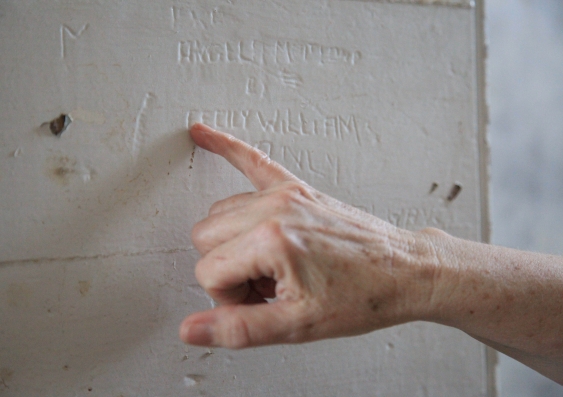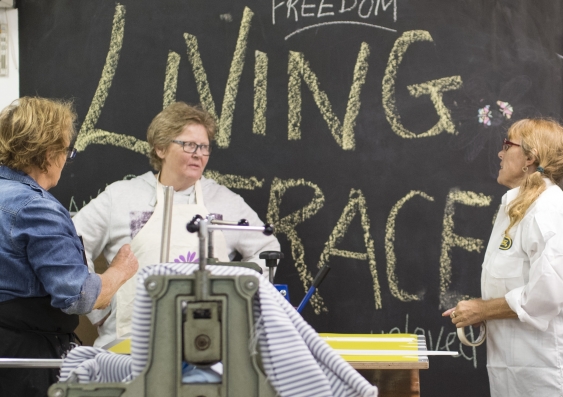Former Parramatta Girls Home residents explore trauma through art
Women who spent their teenage years as residents of Parramatta Girls Home are revealing their physical and mental scars through poignant art works.
Women who spent their teenage years as residents of Parramatta Girls Home are revealing their physical and mental scars through poignant art works.

Fran Strachan
CRC for Low Carbon Livng
0429 416 070
fran.strachan@unsw.edu.au
Women who spent their teenage years as residents of Parramatta Girls Home are revealing their physical and mental scars through poignant art works.
Living Traces, an exhibition of handmade artists’ books and limited edition prints, curated by UNSW Art & Design's Lily Hibberd, captures former residents’ memories, previously buried under systematic denial, trauma and shame.
Based at the former Parramatta Girls Home, the distinctive project has allowed 12 Parragirls (former residents) to retrieve traces of their time as teenagers more than 50 years on.
“These extraordinary works of art witness the resilience of the Parragirls to cross over the threshold into a place of terror to pronounce, ‘Never again’,” says Hibberd, who is a research fellow at UNSW’s National Institute of Experimental Arts.
In 2014, the Royal Commission into Institutional Responses to Child Sexual Abuse held a public hearing into child sexual abuse at the Parramatta Training School for Girls (Parramatta Girls Home) and the Institution for Girls in Hay.
The unique collagraph prints, the result of a year-long collaboration between artist book producers Gwen Harrison and Sue Anderson reveal the marks the Home has left on the women, both physically and mentally.
At the stroke of a pen, my life changed forever. Back then we never got the chance to read what was recorded, to correct or dispute it, or to add our own voice. The only way we could express ourselves was to scratch words into the walls or onto our bodies.
Each print incorporates writing left by the young residents on surfaces in the institution, and personal details from previously inaccessible State Child Welfare records.
Former resident and Living Traces project artist Jenny McNally was only 15 when she was sent to the Girls Home, adjacent to the grounds of the Cumberland Hospital. She returned for the first time two years ago, an experience she describes as “overwhelming”.
“I fell apart, it was haunting walking on the grounds that had caused me so much harm and damage. I was scared of the buildings, but then I realised it wasn’t about the buildings, it was about the people that were in them and the stripping of our dignity and the extreme abuse that went on 24/7.
“At the stroke of a pen, my life changed forever. Back then we never got the chance to read what was recorded, to correct or dispute it, or to add our own voice. The only way we could express ourselves was to scratch words into the walls or onto our bodies.”
“Now a lifetime later, we revisit those marks, we read what was written about us and we are responding in our own ways to set the record right,” McNally said.

Living Traces print workshop with (L-R) Gwen Harrison, Jenny McNally & Sue Anderson. Photo: Lucy Parakhina, 2016.
Today, much of the meaning of the graffiti at Parramatta Girls Home is relevant only to the former residents. Words or acronyms written in coded language, like ILWA/ I Love, Worship Always, were covertly scored on the walls in solitary confinement as an act of solidarity and resistance to the cruelty the girls suffered at the hands of the male staff and others.
“Living Traces offers rare insight into the continuous history of a justice system that criminalises, incarcerates and punishes vulnerable Australian and refugee children to this day,” said Hibberd.
Parragirls is a collective and support group for former residents of the Home founded by Bonney Djuric and Christina Green in 2006. As an independent group, Parragirls advocates for human rights and the public and state recognition of institutional experiences.
Living Traces is part of the wider Parragirls Female Factory Precinct Memory Project, a social history and contemporary art project founded by Bonney Djuric and Lily Hibberd in 2012. Situated at the former Parramatta Girls Home, their work has transformed the once inaccessible site into a place of shared memory and belonging for Parragirls. Living Traces is the third curated PFFP Memory Project exhibition held on site since 2013. The Project is globally recognised as the first Australian member of the 200-strong International Coalition of Sites of Conscience.
What: Living Traces – Parragirls Artist Book and Print Exhibition
When: Opening 4–6pm Saturday 24 Sept. Exhibition opening hours 2–6pm Sun 25 September & Fri 30 September through to Sun 2 October
Where: Kamballa/former Parramatta Girls Home, 1 Fleet Street, Parramatta North, NSW, 2151
High res images and captions available here